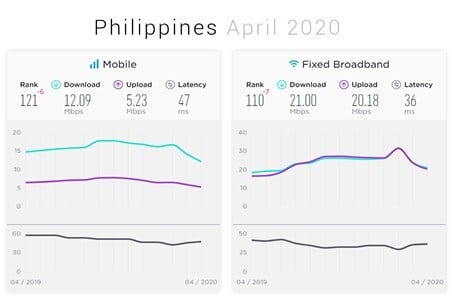
OOKLA’s Speedtest Global Index assessment is done by comparing the different internet speed data around the world. In their recent internet speed test done last April 2020, the Philippines ranked 121st out of 139 surveyed countries in mobile internet speed and 110th out of 174 in fixed broadband internet speed.

This generation lives in an era full of technological advancements and innovation to better human lives, yet the Philippines still falls short in maximizing this opportunity to its benefit. The country’s average mobile internet download speed of 12.09 Megabits per second (Mbps) is significantly far below the global mobile internet download speed of 30.89 Mbps. Moreover, the country’s average fixed broadband internet download speed of 21.00 Mbps also falls below the global fixed broadband internet download speed of 39.62 Mbps. These results only show that the country is still far from a reliable and efficient internet connection.

The main reason why this country is still branded with its slow internet speed is because the country severely lacks cell sites. Compared to 70,000 cell sites of Vietnam or over a million cell sites of China, the Philippines has the lowest cell site density in Asia. The Philippines only has a measly 16,400 active cell sites that serve up to an estimated 67 million internet users.
Despite being negatively branded, why do we still lack these infrastructures? Private sectors intended to construct the cell sites are hindered by the barriers set by the government. There are at least 25 necessary permits and documents needed to secure for a single cell site construction. According to Globe, a major provider of telecommunications services in the Philippines, it can take up to eight months before getting an approval. But what is the government doing to relieve this problem?
Plans for Improvement
The DICT (Department of Information and Communication Technology) is aiming for a policy that will significantly reduce the processing of important documents and permits into 7 days. Another initiative is the Open Access Bill that aims to strengthen competition of networks, empower small broadband providers to build and operate on areas that are not considered feasible by network giants, and provide consistent regulations for data transmission networks.
Despite of having one of the slowest internet connections in Asia, OOKLA said that the Philippines gained a remarkable improvement in internet speed from 2019 to 2020 with an increase of 9.92% in mobile internet speed and 40.75% in fixed broadband internet speed. Furthermore, the internet will be affordable with the arrival of another provider, Mislatel Consortium — the third telecommunications company giant that provides fast, reliable, secure, and more affordable service for the public.

References:
- (2020, April) Philippines’ Mobile and Broadband Internet Speed Test Retrieved June 3, 2020, from https://www.speedtest.net/global-index/philippines
- (2017, August 17). The truth about internet speed in PH – Opinion – INQUIRER.net. Retrieved June 3, 2020, from https://opinion.inquirer.net/106393/truth-internet-speed-ph
- (2018, November 22). Putting Up Cell Sites is Telco Industry’s Single Biggest … – Globe. Retrieved June 3, 2020, from https://www.globe.com.ph/about-us/newsroom/corporate/putting-up-cell-sites-telcos-biggest-challenge.html
- (2019, January 22). DICT to ease permits for cell sites | Philippine News Agency. Retrieved June 3, 2020, from https://www.pna.gov.ph/articles/1059656
- (2019, February 13). Who’s to blame for slow internet | Philstar.com. Retrieved June 3, 2020, from https://www.philstar.com/business/2019/02/13/1893148/whos-blame-slow-internet
- (2020, February 20). Philippines Internet Speed Rank 2020 | Eastvantage. Retrieved June 3, 2020, from https://www.eastvantage.com/newsroom/philippines-internet-speed-rank-2020
- (2019, July 8). PRRD hands Mislatel Consortium permit to operate as 3rd telco. Retrieved June 3, 2020, from https://www.pna.gov.ph/articles/1074398






